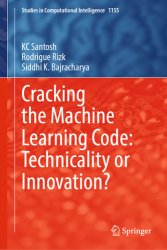Cracking the Machine Learning Code: Technicality or Innovation?
- Добавил: literator
- Дата: 10-05-2024, 18:20
- Комментариев: 0
 Название: Cracking the Machine Learning Code: Technicality or Innovation?
Название: Cracking the Machine Learning Code: Technicality or Innovation?Автор: KC Santosh, Rodrigue Rizk, Siddhi K. Bajracharya
Издательство: Springer
Серия: Studies in Computational Intelligence
Год: 2024
Страниц: 143
Язык: английский
Формат: pdf (true), epub
Размер: 35.1 MB
Typically, applied AI use cases are limited to employing off-the-shelf Machine Learning models, and they range anywhere from healthcare and finance to autonomous systems and agriculture. The journey through technicalities and innovation in the Machine Learning field is ongoing, and we hope this book serves as a compass, guiding the readers through the evolving landscape of Artificial Intelligence (AI). The algorithms and techniques may evolve, but the essence of AI remains timeless. For any innovation by leveraging Machine Learning models on diverse applications/use cases, the focus (of innovation) typically includes model selection, parameter tuning and optimization, use of pre-trained models and transfer learning, right use of limited data, model interpretability and explainability, feature engineering and autoML robustness and security, and computational cost–efficiency and scalability.
Employing off-the-shelf Machine Learning models is not an innovation. Innovation in building Machine Learning models involves a continuous cycle of exploration, experimentation, and improvement, with a focus on pushing the boundaries of what is achievable while considering ethical implications and real-world applicability. Innovative Machine Learning algorithms often build upon a deep understanding of the problem domain, coupled with creative thinking to develop novel approaches that outperform conventional/rudimentary methods. These groundbreaking architectures pave the way for transformative advancements across various industries. Therefore, the pursuit of innovation in Machine Learning continually drives the evolution of AI, pushing the boundaries of what’s possible and shaping the future of technology.
This book emphasizes the importance of moving beyond the constraints of pre-trained models and off-the-shelf basic building blocks to tackle real-world problems effectively. We navigate through three fundamental data types: numerical, textual, and image data, offering practical insights into their utilization across various domains. From predictive analysis in finance and housing markets to text mining from media/news sources, and even abnormality screening in medical imaging informatics, the book spans a wide spectrum of applications. In today's data-driven landscape, the ability of AI models to comprehend the sentiments underlying data is a necessity. Hence, the book explores how AI models can truly prove their worth by understanding and interpreting data sentiments. Moreover, it emphasizes the significance of multimodal learning and representation. By integrating auditory and textual data, we aim to capture nuanced emotions, thereby enhancing sentiment analysis performance. This integration serves as a bridge, connecting spoken and written expressions, and empowers our models to accurately perceive the intricacies of human sentiment.This approach unlocks a deeper understanding of data by seamlessly integrating multiple modalities from the very same source.
In the Chapter 4, we will go through the experimental setup required to proceed further with this book. It is recommended that you become familiar with Python programming language as all the implementation is done with Python programming language. Firstly, we must start setting up an Interactive Development Environment (IDE) for coding Python and discuss some of the most important packages that are used in this book. Python is one of the most popular multi-purpose programming languages. The popularity comes from beginner-friendly syntax and a vast number of libraries and frameworks. Python being an interpreted language makes it easier for programmers to play around with codes. Although newer versions of Python are being released, it is still slower in comparison to its competitors in machine learning such as C++, Scala, and Rust.
Anaconda is one of the most popular platforms for Data Science. It is an open-source platform with its own distribution of Python with thousands of open-source ML, DS, and AI packages. It also has its own package manager called Conda which can be used to install Anaconda packages from Anaconda’s repository. Since it is specifically designed for ML, DS, and AI, it is recommended that you install Anaconda and use its Python instead of manually downloading Python unless you are very familiar with Python environments.
Contents:
Скачать Cracking the Machine Learning Code: Technicality or Innovation?
Внимание
Уважаемый посетитель, Вы зашли на сайт как незарегистрированный пользователь.
Мы рекомендуем Вам зарегистрироваться либо войти на сайт под своим именем.
Уважаемый посетитель, Вы зашли на сайт как незарегистрированный пользователь.
Мы рекомендуем Вам зарегистрироваться либо войти на сайт под своим именем.
Информация
Посетители, находящиеся в группе Гости, не могут оставлять комментарии к данной публикации.
Посетители, находящиеся в группе Гости, не могут оставлять комментарии к данной публикации.

